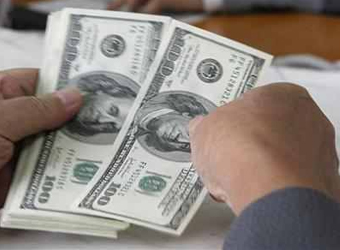Dollar prices edged off from a nine-month low against a basket of currencies on Monday, but it remained shaky as signs central banks in Europe were moving away from accommodative monetary policies kept the euro and sterling well supported.
The dollar index against a group of six major currencies was 0.1 percent higher at 95.729, crawling off a nine-month trough of 95.470 plumbed on Friday.
The greenback was hit hard last week as hawkish comments from central bankers increased expectations that the European Central Bank, the Bank of England and Bank of Canada would eventually shift to tighter monetary policy.
The dollar added 0.1 percent to 112.435 yen after briefly falling to 111.900 earlier before climbing back quickly.
“The Tokyo election won’t have a strong market impact, in my view, as there are no opposition parties in Japan that can immediately replace the (ruling) LDP,” said Yukio Ishizuki, senior currency strategist at Daiwa Securities.
“The currency market is more focused on monetary policy changes in Europe and other regions. That the BoE and BOC now appear to be in a hurry to normalise monetary policy was a big surprise last week.”
The Bank of Japan, still deeply committed to monetary easing, was seen being left behind with its Group of Eight counterparts already on the path towards monetary tightening or seemingly headed towards it.
“It would be inevitable for the BOJ to be seen as the odd one out, still sticking to its large-scale easing, and provide strategic incentive for speculators,” said Koji Fukaya, president at FPG Securities in Tokyo.
“An environment is being set up in which the yen depreciates while others gain.”
The euro fell 0.1 percent to $1.1413 after reaching a near 14-month high of $1.1445 on Friday.
Skepticism that the Federal Reserve would be able to raise interest rates again this year amid a recent batch of weak U.S. economic data have further boosted the euro.
The pound was down 0.2 percent at $1.3003 following an advance on
Friday to $1.3030, its strongest since May 23.
The Canadian dollar was 0.15 percent weaker at C$1.2985 per dollar.
It was still within reach of C$1.2947, its strongest in nine-months, marked on Friday thanks to higher oil prices and a central bank report that further bolstered rate hike expectations.
Canadian companies are more optimistic about future sales and exports, while improving demand is driving capacity pressures that should boost investment and hiring, the BOC said in a report on Friday.
The Australian dollar was 0.15 percent lower at $0.7678.
The currency kept close to a three-month high of $0.7712 scaled on Friday against a wobbly dollar on a combination of higher commodity prices and China’s official Purchasing Managers’ Index (PMI) showing strong factory growth.
However, Monday’s Caixin/Markit PMI private survey that also pointed to firm factory growth in China – Australia’s major trading partner – drew little reaction from the Aussie.
The New Zealand dollar slipped 0.2 percent to $0.7320 after touching a five-month high of $0.7347 on Friday against a broadly weaker dollar.
Source: Reuters


